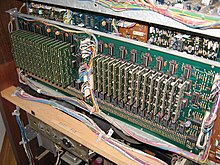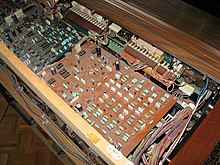Farfisa Pergamon
| Farfisa Pergamon |
|---|

|
| Footings |
| Upper manual: 9 (can be doubled) |
| Lower manual: 5 (can be doubled) |
| Pedals: 2 |
| General |
| Production: 1981–1984 |
| Weight: approx. 200 kilograms |
| Purchase price (1984): 16,000 DM |
The Farfisa Pergamon is an analog electronic spinet organ from the Italian company Farfisa (FAbbriche Riunite di FISArmoniche). It was presented to the public in 1981 and was in the upper price segment with a sales price of DM 16,000. Due to the high weight of almost 200 kilograms and the large dimensions of the gaming table, this model was only produced as a free-standing model. A transportable variant was not offered. The solid wooden housing and the burl wood design of the console give this organ with the marbled switches the typical Italian design. The lighting of the control elements and the note holder is done by numerous festoon lamps . In this organ, Farfisa relied on an elaborate mechanical Leslie and not on an electronic simulation. The production of the Farfisa Pergamon was discontinued in 1984 due to the previous takeover by the Bontempi company.
Gaming table
The console has 2 manuals with 4 octaves each . 9 foot positions are available for the upper manual, whereas the lower manual is equipped with 5 foot positions. The Pergamon achieves a remarkable volume of sound through a separately switchable doubling of the foot position of both manuals. The division of the console into 9 groups facilitates the organist 's overview and quick configuration of the organ. The console is illuminated by 9 festoons, which provide a warm and glare-free light below the music holder over the entire width of the organ. The upper manual is shifted one octave to the right to the lower manual. When not in use, the entire play area can be protected against dirt and damage by a large roll cover.
Main configuration unit
All basic settings of the organ are made in this group. The setting for the upper and lower manual and the configuration of the pedals are made using toggle switches that activate the various groups and set them to the desired play area. The addition of the monosynthesizer settings to the pedals can be found here as well as the activation of the percussion, wind and string instruments, which of course can be regulated in brilliance and volume . In addition, there are special functions for the groups mentioned that allow special modulations. The entire organ can be adjusted to a specific pitch by pitching it without having to play it explicitly.
Rhythm unit
The rhythm unit is defined by 16 basic rhythms, which are composed as follows:
Bossanova, Samba, ChaCha, Rock 1, Disco, Swing, March, Waltz, Beguine, Rhumba, Afro, Rock2, Slow Rock, Dixie, March, Jazz Waltz
Each rhythm has a second variant, which differs through changed percussion. Corresponding solos can be inserted manually or automatically into predefined measures. A background voice can be assigned to the individual rhythm, which can consist of harpsichord, organ, strings, funky or brass. For the bass accompaniment you can choose between alternating and running bass. The rhythm can be regulated in speed and volume, with a preprogrammed standard speed available for each separate rhythm.
Monosynthesizer
The Farfisa Pergamon has an LFO synthesizer (Low Frequency Oscillator), which consists of several basic instruments and which can be individually modulated. It consists of the following instruments : trombone, trumpet, sax, clarinet, oboe, piccolo, violin, harmonica, pan flute and electric guitar. The modulation of the solo instruments is carried out with the corresponding sliders, which cover the areas of Volume, Brilliance, Emphasis, Attack, Delay, Portamento, Speed and Vibration Depth. With the appropriate combination options, the organist opens up a wide range of different sounds and new, self-made instruments. The sound variations can be assigned to the upper manual or the pedals. Thanks to a keyboard touch function, which gives the upper manual adjustable pressure sensitivity, it can be combined with other instruments at any time by pressing the keys more intensively. The "Noise" function switches on blowing noise, which in conjunction with the pan flute or saxophone creates a very realistic sound.
Drawbar system
The organ sound of the Pergamon is configured via the drawbar system on the left of the upper manual. 5 drawbars for the lower manual and 9 drawbars for the upper manual allow the precise setting of the desired sound volume through a fine grid. A special function allows the number of feet to be doubled to 18 or 10. The pedals are excluded.
Upper manual: 16, 5 1/3, 8, 4, 2 2/3, 2, 1 3/5, 1 1/3, 1
Lower manual: 8, 4, 2 2/3, 2, 1
A simulation of the electromechanical click of the older Hammond organs can be activated in various variations.
Polyphonic instruments
The polyphonic group contains 3 subgroups. Each instrument or group of instruments can be changed by adjusting the volume and brilliance accordingly. The string group also has an echo and delay function.
Group 1: Piano, Harpsichord, Honky Tonk, Electric Guitar, Classic Guitar
Group 2: Brass, Reed, Accordion
Group 3: strings 8, strings 4
These instrument groups can be modulated and changed using other special functions.
Fixed register
The Pergamon has 24 general presets that provide pre-programmed sound variations that can be called up by the organist at the touch of a finger. The current program number is indicated on a 2-digit LED display. 4 general presets are reserved for your own sound creations and can be assigned individually. A color assignment of the main groups facilitates the selection from the areas Organ, Percussion, Brass and Strings. The fixed registers include the configuration of the entire organ. In order to cover a particularly wide spectrum of sounds, the organist can combine the manual configuration with the fixed registers. A mechanical device under the gaming table, the "knee lever", makes this possible. By pressing it, the previously selected fixed register is activated in fractions of a second and the organ is reconfigured.
modulation
The modulation is used to adapt and change the basic voices from the field of polyphonic instruments and the monosynthesizer. The result is a softer, slightly vibrating effect. The percussion instruments get a honky tonk effect through a slight shift in tone, which produces the familiar sound of a "western piano" especially on the piano. The setting of the mechanical Leslie for the speed and separate activation of the manuals is also carried out in this group. This modulation gives the group of string instruments a richer sound volume.
"Vocal Chorus"
This "human choir" was introduced in 1981 by the Farfisa company. It is a very real-looking chant that can be configured in 3 stages or individually. The assignment to the upper or lower manual and the fine adjustment via the controls for volume adjustment, delay and echo function allow extensive effects. Especially in sacred pieces, this choir comes into its own in connection with the 18 foot positions. This feature can also be used as a background for normal pieces, which creates an overall coherent sound. The vocal chorus has its own pitching to adjust the key.
Pedals
The Pergamon pedals consist of 13 stub pedals with 2 foot positions. These can be combined with the instruments string bass, bass guitar, electric bass, sax and trombone. Adding and modulating the monosynthesizer voices on the pedals allows for a wide variety of sound variations.
Foot positions of the pedals: 16, 8
Technical picture documentation
The Farfisa Pergamon technology is accessed through a rear wall that is screwed several times and can be removed with the help of two handles. The top cover is pulled back out of the guides and reveals the upper main circuit boards as well as the circuit boards for the rhythm section and the synthesizer. The upper cover plate contains the two current collectors for the music stand lighting. The main boards are mounted vertically on three levels, which can be folded out using appropriate swivel joints and facilitate access. The two manuals are connected to the case from below by two screws each and are folded up using two lateral swivel joints to give access to this area of the case, the modulation group and the “vocal chorus”. The lower part of the housing contains the primary power supply and the transformer unit . The housing of the mechanical Leslie and the other loudspeakers are clearly arranged and easily accessible.
The following pictures document the interior structure of the Farfisa Pergamon:
Web links
- FarfisaMusic - Farfisa musical instruments
- Farfisa - Farfisa telecommunications technology
- BontempiGroup - Bontempi musical instruments
- Demonstration of the organ on YouTube - 4:55 minutes (in Italian)











